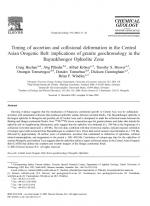Добрый день, Коллеги. Важное сообщение, просьба принять участие. Музей Ферсмана ищет помощь для реставрационных работ в помещении. Подробности по ссылке
Timing of accretion and collisional deformation in the Central Asian Orogenic Belt: implications of granite geochronology in the Bayankhongor Ophiolite Zone
Growing evidence suggests that the mechanism of Palaeozoic continental growth in Central Asia was by subduction– accretion with punctuated collisions that produced ophiolitic sutures between accreted blocks. The Bayankhongor ophiolite is the largest ophiolite in Mongolia and possibly all of Central Asia, and is interpreted to mark the collisional suture between the Baidrag and Hangai continental blocks. New 207Pb/206Pb zircon evaporation ages for granite plutons and dykes that intrude the ophiolite and its neighbouring lithotectonic units suggest that the ophiolite was obducted at c. 540 Ma at the beginning of a collisional event that lasted until c. 450 Ma. The new data, combined with that of previous studies, indicate regional correlation of isotopic ages north-westward from Bayankhongor to southern Tuva. These data record oceanic crust formation at c. 570 Ma, followed by approximately 30 million years of subduction–accretion that culminated in obduction of ophiolites, collision related metamorphism, and magmatism in the period c. 540–450 Ma. Correlation of isotopic-age data for the ophiolites of western Mongolia and southern Tuva suggests that the ophiolites define a major collisional suture in the Central Asian Orogenic Belt (CAOB) that defines the southern and western margins of the Hangai continental block.
The Central Asian Orogenic Belt (CAOB) is a complex collage of island arcs, continental blocks and fragments of oceanic crust that amalgamated during the Palaeozoic to Mesozoic. Recent studies provide growing evidence that continental growth occurred through a process of subduction–accretion with punctuated collisional events resulting in the formation of ophiolitic sutures between accreted blocks (Hsu¨ et al., 1991; Mossakovsky et al., 1994; Buchan et al., 2001). However, despite an improved understanding of the crustal growth mechanisms, a paucity of reliable geochronological data has hindered correlation of sutures and collisional deformation within the orogen, or has led to questionable models based solely on lithological similarity. One such example is the grouping of high-grade gneiss terranes in western Mongolia and Tuva into a singular Archaean to Palaeoproterozoic continental block named the Tuva–Mongolian Massif (Mossakovsky et al., 1994; Dergunov et al., 1997). However, Kozakov et al. (1999) showed that granulite-facies gneisses in Tuva, previously assumed to represent part of the Tuva–Mongolian Massif, are early Cambrian in age (536F6 Ma, U–Pb single zircon). Miscorrelation has led to confusing regional relationships, and misunderstanding of the mechanisms of continental growth (see Lamb and Badarch, 1997; Buchan et al., 2001 for detailed discussion).
Mongolia occupies a central position within the Central Asian collage and is therefore pivotally located for understanding crustal growth in the region. This paper presents new zircon geochronological data from granites and rhyolite dykes that intrude the Bayankhongor ophiolite zone, which is the largest ophiolitic suture in Mongolia, and possibly all of Central Asia (Fig. 1, Buchan et al., 2001). The new
data, combined with previously published K–Ar and Ar–Ar data from metamorphic micas associated with faults within the ophiolite zone (Teraoka et al., 1996; Kurimoto et al., 1998; Takahashi et al., 1998b; Delor et al., 2000; Ho¨ck et al., 2000), provide important constraints on the timing of obduction of the Bayank-hongor ophiolite and subsequent deformation. In addition, it is demonstrated that the deformation events associated with creation of the Bayankhongor granites can be traced on a regional scale north-westward along-strike to Tuva, southern Siberia. The correlation of these deformation events suggests that they represent a major magmatic episode in the history of the CAOB.




